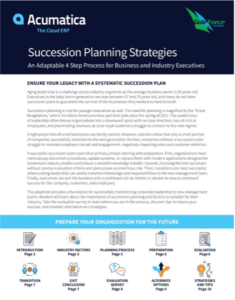Include Acumatica in Your Succession Planning for a Successful Transition
Choosing a successor and planning for a future transition is a critical step for business leaders. As the workforce ages, many companies find themselves without a plan for the future. This lack of planning can lead to a host of issues, from insufficient organizational continuity to a decline in morale and revenue. The problem has been made especially evident by the recent “Great Resignation”, where more than 33 million Americans have quit their jobs in the last few years.
Moreover, with a high percentage of businesses being family-owned, the transition to the next generation is fraught with challenges. A successful succession plan is not just a matter of picking a successor; it involves ensuring that the organization, its processes, and its collective knowledge are effectively transferred. Here is where technology, specifically cloud ERP systems like Acumatica, can play a pivotal role.
Step 1: Prepare for Succession
The first step in securing your business’s future through succession planning involves a thorough preparation phase that sets the groundwork for a seamless transition. Key activities include:
- Documenting All Business Procedures: Create detailed records of all current business processes, ensuring they are up-to-date and reflective of the best practices within your industry.
- Evaluating and Updating Systems: Assess your current systems for any inefficiencies or outdated technologies that could hinder progress. Implement modern solutions, like Acumatica ERP, that provide a robust platform that supports real-time decision-making, integrates various business functions, and is adaptable to the evolving needs of the industry, thereby supporting future business needs.
- Retaining Key Employees: Identify and retain employees who are crucial to the operation of your business. Their industry experience and institutional knowledge will be invaluable during the transition.
The goal during this initial phase is to establish a strong foundation upon which the future leadership can build. This involves not just preserving the status quo but enhancing the business’s capabilities through strategic updates and improvements.
Step 2: How to Choose the Right Successor
Choosing the right successor is a critical decision that can significantly impact the future of your business. This step requires careful consideration of both the needs of the business and the pool of potential candidates to ensure a thoughtful selection process, consider the following key points:
- Identify Potential Successors Early: Begin by identifying potential successors from within your organization or family, considering their interests, aptitudes, and alignment with the business’s values and goals. For businesses without a clear internal candidate, looking externally might be necessary, requiring a different approach to evaluation.
- Establish Clear Criteria for Selection: Develop a set of objective criteria that the successor must meet. This can include leadership skills, industry knowledge, experience with similar organizations, and the ability to innovate and adapt to changing market conditions. These criteria will serve as a benchmark for evaluating potential successors.
Choosing the right successor may involve a combination of internal mentoring and external recruitment to find the ideal candidate. Through structured evaluation and careful consideration, businesses can make a well-informed decision that ensures the continuity and growth of the company in the hands of the next leader.
 Step 3: Groom Them for Success with Knowledge and Feedback
Step 3: Groom Them for Success with Knowledge and Feedback
Once the right successor has been chosen, the focus shifts to training them. This involves not just transferring knowledge but also shaping the future leader’s approach to management, decision-making, and strategic planning. Consider the following strategies:
- Structured Knowledge Transfer: Implement a comprehensive knowledge transfer plan that covers all critical areas of the business. This can include shadowing current leaders, participating in strategic meetings, and managing pilot projects. If you’re using an ERP system like Acumatica, give them hands-on experience with the systems and data they’ll be working with.
- Regular Feedback and Support: Provide ongoing feedback to your successor, offering both praise and constructive criticism. Regular check-ins can help address any concerns or gaps in knowledge, ensuring they feel supported throughout the transition.
Grooming your successor is a dynamic process that requires patience, commitment, and a willingness to invest in their development. Through thoughtful preparation and guidance, you can equip your successor to lead the business into the future successfully.
Step 4: Making a Graceful Exit
Making a graceful exit is the final step in the succession planning process. The outgoing leader steps back in a way that ensures the continued success of the business under the new leadership. The transition should be smooth, maintaining the confidence of employees, customers, and stakeholders throughout the changeover. Key considerations include:
- Plan Your Exit Strategy: Clearly define the timeline and conditions of your exit. Establishing a timeline with key milestones helps manage expectations and provides a clear roadmap for the transition.
- Maintain a Supportive Role: Transition to a mentorship or advisory role. Be available to answer questions and provide advice while allowing the successor to make decisions and lead the organization.
By carefully planning the exit and supporting the new leader, the transition can strengthen rather than destabilize the organization. Ultimately, a well-executed exit ensures the longevity and success of the business.
Leverage Technology as a Foundation for the Future
Deploying Acumatica as your ERP system ensures all organizational knowledge, processes, and customer relationships are maintained and accessible. With features like real-time data access, integrated workflows, and mobile capabilities, Acumatica prepares your company for a successful transition to the next generation of leaders. Key benefits include:
- Centralized Information: Ensure that all business data, from financial records to customer interactions, is stored in a centralized, accessible system. This consolidation facilitates smoother knowledge transfer and provides a single source of truth for the incoming leadership.
- Process Automation and Efficiency: Utilize technology to automate routine tasks, streamline business processes, and enhance overall efficiency. Modern ERP systems like Acumatica can significantly reduce manual workloads, allowing future leaders to focus on strategic decision-making and growth rather than trying to make order out of chaos.
Leveraging Acumatica for your business operations prepares the organization for future challenges and opportunities. The scalability of cloud ERP ensures that the technological infrastructure grows alongside the business, accommodating new processes, products, or markets without the need for costly upgrades or replacements. In this way, businesses can ensure a bright future.
Including Acumatica in your succession planning is crucial for a successful transition. By systematically preparing for the future, choosing the right successor, and leveraging the right technology, you can ensure your organization thrives in the hands of the next generation.
 Want an in-depth look at succession planning? Download our free whitepaper on succession planning strategies.
Want an in-depth look at succession planning? Download our free whitepaper on succession planning strategies.
For more information on implementing Acumatica and ensuring a seamless transition, contact Gale Force Consulting. Let us help you safeguard your legacy and prepare for a successful future.


